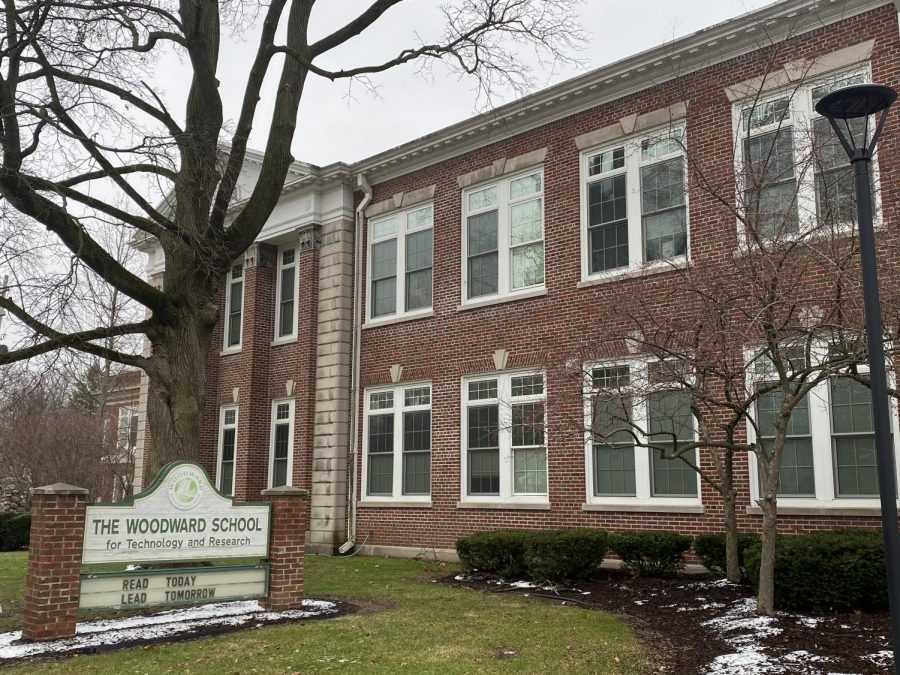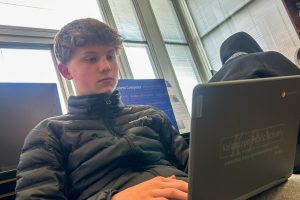The KPS community shares their thoughts on year-round schooling
Credit: Audreanna Dunton
the front of Woodward Elementary during the school day. Woodward is one of the schools in KPS testing year round school, which is testing year round schooling.
January 22, 2020
It’s the last day of school before the summer starts all of your exams are completed, you’re saying your goodbyes to your favorite teachers and all of your friends. You feel a sense of relief because the long school year has finally come to an end and you’re looking forward to a summer full of spending time outdoors, hanging out with your friends, and staying up as late as you want.
Many students enjoy having a summer break from school. Whether you are a student in elementary school or high school, a three month break during the warmest and sunniest months of the year has been normalized to students and families. However, many Michigan schools are proposing the idea that students in the K-12 grade levels begin going to school all year-round.
“I don’t like the idea of year round schooling because I really don’t have to do anything during the summer and it’s nice, it’s stress free,” said Loy Norrix sophomore Annaliese Bol.
Some Michigan schools have already transitioned to the year-round schooling schedule, but Kalamazoo Public Schools has yet to do so throughout the entire district. As of right now, there are only a couple of schools that have made the switch. Woodward School for Technology and Washington Writers’ Academy are both KPS elementary schools and, as of now, the only schools in the KPS district who have adapted to this new schedule, called a “Balanced Calendar” within the KPS district.
The Kalamazoo Public Schools Board of Education voted in January to switch Woodward School for Technology and Research and Washington Writers’ Academy to a year-round balanced calendar after the state threatened to close both due to low academic performance, as stated in an MLive article.
“It seems smart for the fact that you can learn more, but it gives you less time to do things like hanging out with your friends,” said sophomore Hank Perkins.
Many schools with the year-round schooling schedule claim that they have already been seeing improvement in their students’ education, including test scores, attendance, and even improved focus.
“…I have seen many positive academic success due to the year round schedule. When students returned to school in July, they were at the same reading level or higher.
I think that this is due to the fact that we only had 4 weeks off in the summer and that many children are reading over the breaks. Many students were able to easily sync back into school routines as well,” said Bethany Caswell, a fourth grade teacher at Woodward Elementary.
Many see the benefits of year-round schooling within schools from kindergarten all the way to senior grade levels.
“I love the idea of year-round school. I think that more frequent breaks throughout the school year and a shortened summer break would help with burnout and ‘summer slide’,” said Christina Holmes, a Spanish teacher at Loy Norrix.
With a year-round schooling schedule, students would attend school for the same 180 day school year, but instead of taking a three month break during the summer season, the schools would prolong the 180 days over the course of the whole year, taking shorter, yet more frequent breaks throughout the entire year.
“I feel like year-round schooling wouldn’t be helpful for students. The frequent breaks would cause students to get off track and lose momentum. I think they would be less motivated and procrastinate,” said senior Addy Alexopoulos.
Experts from the National Education Association say that transitioning to this new schedule comes with many benefits, such as “increased retention rates” from not having such a long amount of non-educational time during summer break, a “more efficient use of school space” due to the building being occupied all year round, rather than being left unoccupied for the summer, and also, students reaping the benefits of getting help when they are struggling, instead of a whole summer filled with no guidance from teachers or school counselors.
“Students are able to access the food pantry year-round and other Community in Schools resources. Students are able to get their basic needs met like food, clothing, etc.,” said Caswell.
However, the same critics from the National Education Association also argue that if an entire school district doesn’t adopt this type of school-year calendar, parents may have students on completely different schedules for school and breaks, and that extra-curricular activities may struggle with scheduling and out of schools practices, rehearsals, and events.
“Some challenges are that families with multiple siblings on middle and high school schedules do not match. For example, my son is at Kalamazoo Central, we have to communicate clearly about our different breaks in order to help our family life run smoothly.
Some families may also get confused if they don’t have an accurate/up-to-date calendar with year-round breaks listed. Woodward Office Staff do a wonderful job of sending home reminder notes to families as well,” said Caswell.
There are many different opinions circulating throughout both Michigan, and the Kalamazoo educational community. Educators, parents, and students, all have been making these scheduling transitions within these two schools in the KPS district.












